NCERT Solutions for Exercise 7.4 Class 9 Maths Chapter 7 - Triangles
Exercise 7.4 Class 9 Maths deals with problems related to the relationship between the triangle's unequal sides and the angles on the opposite side. When two triangle sides are unequal, the angle opposite to the bigger side(longest side) is larger.
This Story also Contains
- Triangles Class 9 Chapter 7 Exercise: 7.4
- More About NCERT Solutions for Class 9 Maths Exercise 7.4 -
- Benefits of NCERT Solutions for Class 9 Maths Exercise 7.4
- NCERT Solutions of Class 10 Subject Wise
- Subject Wise NCERT Exemplar Solutions
Triangle disparity: The sum of the lengths of any two triangle sides should be always greater than the length of the third side. In any triangle, the side opposite to the bigger angle is longer. Exercise 7.4 Class 9 Maths incorporates the outline of all activities and their application. Thus, we need to go through the outline of the part. At the point when two figures have the same (and exact) shape and size, they are supposed to be congruent.
Along with NCERT book Class 9 Maths, chapter 8 exercise 7.4 the following exercises are also present.
Triangles Class 9 Chapter 7 Exercise: 7.4
Q1 Show that in a right-angled triangle, the hypotenuse is the longest side.
Answer:
Consider a right-angled triangle ABC with right angle at A.
We know that the sum of the interior angles of a triangle is 180.
So, $\angle A\ +\ \angle B\ +\ \angle C\ =\ 180^{\circ}$
or $90^{\circ}\ +\ \angle B\ +\ \angle C\ =\ 180^{\circ}$
or $\angle B\ +\ \angle C\ =\ 90^{\circ}$
Hence $\angle B$ and $\angle C$ are less than $\angle A$ ( $90^{\circ}$ ).
Also, the side opposite to the largest angle is also the largest.
Hence the side BC is largest is the hypotenuse of the $\Delta ABC$ .
Hence it is proved that in a right-angled triangle, the hypotenuse is the longest side.
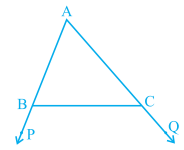
Answer:
We are given that,
$\small \angle PBC < \angle QCB$ ......................(i)
Also, $\angle ABC\ +\ \angle PBC\ =\ 180^{\circ}$ (Linear pair of angles) .....................(ii)
and $\angle ACB\ +\ \angle QCB\ =\ 180^{\circ}$ (Linear pair of angles) .....................(iii)
From (i), (ii) and (iii) we can say that :
$\angle ABC\ > \ \angle ACB$
Thus $AC\ > AB$ ( Sides opposite to the larger angle is larger.)
Q3 In Fig., $\small \angle B <\angle A$ and $\small \angle C <\angle D$ . Show that $\small AD <BC$ .
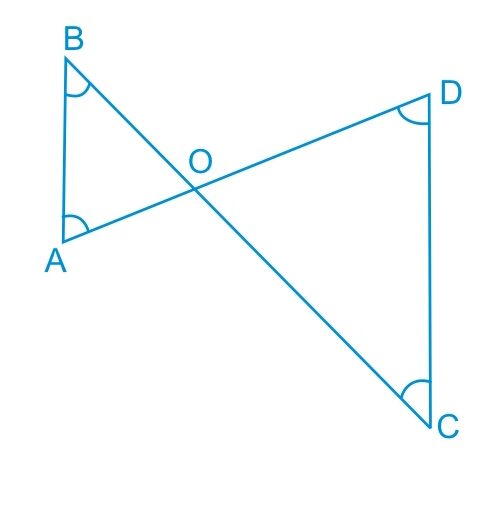
Answer:
In this question, we will use the property that sides opposite to larger angle are larger.
We are given $\small \angle B <\angle A$ and $\small \angle C <\angle D$ .
Thus, $BO\ > AO$ ..............(i)
and $OC\ > OD$ ...............(ii)
Adding (i) and (ii), we get :
$AO\ +\ OD\ <\ BO\ +\ OC$
or $AD\ <\ BC$
Hence proved.
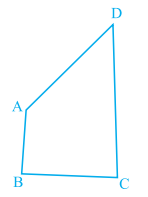
Answer:
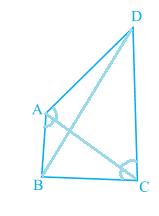
Consider $\Delta ADC$ in the above figure :
$AD\ <\ CD$ (Given)
Thus $\angle CAD\ > \angle ACD$ (as angle opposite to smaller side is smaller)
Now consider $\Delta ABC$ ,
We have : $BC\ > AB$
and $\angle BAC\ > \angle ACB$
Adding the above result we get,
$\angle BAC\ +\ \angle CAD > \angle ACB\ +\ \angle ACD$
or $\small \angle A>\angle C$
Similarly, consider $\Delta ABD$ ,
we have $AB\ <\ AD$
Therefore $\angle ABD\ > \angle ADB$
and in $\Delta BDC$ we have,
$CD\ >\ BC$
and $\angle CBD\ >\ \angle CDB$
from the above result we have,
$\angle ABD\ +\ \angle CBD\ >\ \angle ADB\ +\ \angle CDB$
or $\small \angle B>\angle D$
Hence proved.
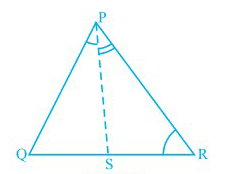
Answer:
We are given that $\small PR>PQ$ .
Thus $\angle PQR\ =\ \angle PRQ$
Also, PS bisects $\small \angle QPR$ , thus :
$\angle QPS\ =\ \angle RPS$
Now, consider $\Delta QPS$ ,
$\angle PSR\ =\ \angle PQR\ +\ \angle QPS$ (Exterior angle)
Now, consider $\Delta PSR$ ,
$\angle PSQ\ =\ \angle PRQ\ +\ \angle RPS$
Thus from the above the result we can conclude that :
$\small \angle PSR>\angle PSQ$
Answer:
Consider a right-angled triangle ABC with right angle at B.
Then $\angle B\ >\ \angle A\ or\ \angle C$ (Since $\angle B\ =\ 90^{\circ}$ )
Thus the side opposite to largest angle is also largest. $AC\ >\ BC\ or\ AB$
Hence the given statement is proved that all line segments are drawn from a given point, not on it, the perpendicular line segment is the shortest.
More About NCERT Solutions for Class 9 Maths Exercise 7.4 -
From NCERT solutions for Class 9 Maths chapter 7 exercise 7.4, we get to know the inequalities of triangles and a few more theorems. The problems related to those are solved n the Class 9 Maths exercise 7.4. The following points also help in solving the problems of NCERT syllabus Class 9 Maths chapter 7.
- An equilateral triangle has 60 degrees of angle on each side.
- The two triangles are congruent if the three sides of one triangle are equal to the three sides of the other triangle (SSS Congruence Rule).
- The two triangles are congruent if the hypotenuse and one side of one triangle are equal to the hypotenuse and one side of the other triangle (RHS Congruence Rule).
Also Read| Triangles Class 9 Notes
Benefits of NCERT Solutions for Class 9 Maths Exercise 7.4
Exercise 7.4 Class 9 Maths, is based on INEQUALITIES IN A TRIANGLE and its uses.
From Class 9 Maths chapter 7 exercise 7.4 we can roughly guess which side is greater by knowing the angle opposite to it.
Understanding the concepts from Class 9 Maths chapter 7 exercise 7.4 will allow us to understand the concepts related to a higher standard which includes difficult questions related to INEQUALITIES IN A TRIANGLE
Also, See
NCERT Solutions of Class 10 Subject Wise
Subject Wise NCERT Exemplar Solutions
Popular Questions
Courses After 12th
Applications for Admissions are open.
As per latest syllabus. Physics formulas, equations, & laws of class 11 & 12th chapters
JEE Main Important Chemistry formulas
Get nowAs per latest syllabus. Chemistry formulas, equations, & laws of class 11 & 12th chapters
JEE Main high scoring chapters and topics
Get nowAs per latest 2024 syllabus. Study 40% syllabus and score upto 100% marks in JEE
JEE Main Important Mathematics Formulas
Get nowAs per latest syllabus. Maths formulas, equations, & theorems of class 11 & 12th chapters
